![]()
![]()
![]()
Use LEFT and RIGHT arrow keys to navigate between flashcards;
Use UP and DOWN arrow keys to flip the card;
H to show hint;
A reads text to speech;
61 Cards in this Set
- Front
- Back
- 3rd side (hint)
|
M1 in taurus
|
crab nebula
|
|
|
|
M13 in hercules
|
hercules cluster
|
|
|
|
M15 in pegasus
|
globular cluster
|
|
|
|
M16 near Sagittarius
|
Eagle nebula
|
|
|
|
M31 Andromeda
|
Andromeda galaxy
|
|
|
|
M42 in orion
|
great orion nebula
|
|
|
|
M45 in taurus
|
Pleiades
|
|
|
|
M51 near Ursa major
|
whirlpool galaxy
|
|
|
|
M57 in lyra
|
ring nebula
|
|
|
|
diffuse nebula
|
M16 and M42
|
|
|
|
planetary nebula
|
M57
|
|
|
|
supernova remnant
|
M1
|
|
|
|
open star clusters
|
M45
|
|
|
|
globular star clusters
|
M13 M15
|
|
|
|
galaxies
|
M31 M51
|
|
|
|
Charles Messier
|
comet hunter cataloged fuzzy patches that look like comets. comets move fuzzy patches don't.
|
|
|
|
new stars form
|
inside diffuse nebulae
|
|
|
|
protostars form
|
within a dust cloud and are mostly visible (but not in the infrared)
|
|
|
|
hydrogen fusion
|
when the star collapses it heats up and reaches hydrogen fusion temperatures.
|
|
|
|
Red dwarf
|
stars that are much more fainter, cooler, and smaller than the sun and is the most common type of star in our galaxy
|
|
|
|
brown dwarfs
|
substellar objects which are too low in mass to sustain stable hydrogen fusion. but they can slowly fuse heavy hydrogen into helium.
|
|
|
|
dying large mass stars
|
large stars often fluctuate in brightness and have large gas eruptions. they often lose mass through their eruptions.
|
|
|
|
death of larger giant stars
|
much of its mass is thrown into space with a neutron star in the middle. if enough is left it will form a black hole.
|
|
|
|
after supergiant stage
|
hypernova will create an initial flare up that can take seconds and last for weeks to months there may cause gamma ray bursts.
|
|
|
|
What are open star clusters?
|
modest sized and are found in the disk of the galaxy and their stars tend to be quite young.
|
|
|
|
What are globular clusters
|
they are found in the halo and are spherical collections of old low metal stars that orbit a galactic core as a satellite and are tightly bound by gravity. also some of the first stars to be produced in galaxy
|
|
|
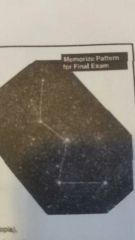
|
casseopeia the vain queen. wife of King cephus and mother of Andromeda
|
|
|
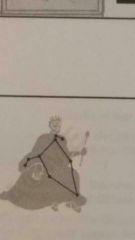
|
cephus king husband of casseopeia and father of Andromeda
|
|
|
|
delta cephei
|
they are dying high mass stars with helium cores that regularly expand and contract pulsing from a day to 50 days
|
|
|
|
inverse square law
|
What we use to determine distances to these stars by how bright they appear from Earth
|
|
|
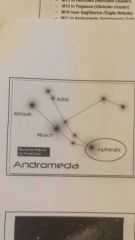
|
Andromeda
|
|
|
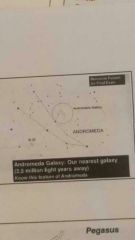
|
nearest galaxy 2.5 million light years away.
|
|
|

|
taurus
|
|
|
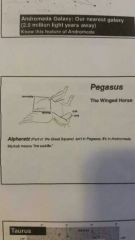
|
great square of pegasus
|
|
|
|
supernovas
|
any star that is greater than about 8 solar masses can die in this form of a supernova explosion.
|
|
|
|
how many known globular clusters occur in milky way
|
158 while others galaxies like Andromeda has 500 that occur
|
|
|
|
oldest globular cluster is found where?
|
in pegasus M15 an estimated 13.2 billion years old
|
|
|
|
What might have formed in the center of M15
|
a 4000 solar mass black hole
|
|
|
|
ring nebula in lyra
|
central star is a planet sized white dwarf and it said to be the fate of our sun one day
|
|
|
|
planetary nebulae
|
actually a glowing shell of gas and plasma formed by certain types of stars when they die. when it uses up its central fuel it ejects a significant portion of its mass into a gassy shell.
|
|
|
|
saturn
|
probably the most distinctive to see in a telescope and not nearly as easy to see.
|
|
|
|
diffuse nebulae
|
thin but widespread clouds of gas and dust. frequently places of star formation.
|
|
|
|
diffuse nebulae types
|
emission nebulae, and reflection nebula
|
|
|
|
emission nebulae
|
contain very hot and massive young stars that excite the gas cloud with UV light.
|
|
|
|
reflection nebula
|
results from cooler stars simply reflecting their light of the dust in the cloud (often blue)
|
|
|
|
Virgo cluster of galaxies
|
one of our closest galaxy clusters. is located in Virgo constellation.
|
|
|
|
lenticular galaxies
|
spiral galxies without spiral structure.
|
|
|
|
elliptical galaxies
|
ellipisodial shape no arms, and do not rotate as a whole, mostly old stars no star formation.
|
|
|
|
irregular galaxies
|
usually distorted by the gravitation of their intergalactic neighbors.
|
|
|
|
open clusters are what?
|
group of stars that were formed from the same giant molecular cloud and are still loosely gravitationally bound to each other. our sun used to be apart of an open cluster.
|
|
|
|
What is a star?
|
a large ball of gas. hot enough in its core to burn hydrogen into helium. it can have masses over a hundred times of our sun.
|
|
|
|
nuclear fusion
|
occurs in the core of stars and keeps stars from collapsing. releases energy by combining light elements into heavier elements. requires extremely hot temp. and densities.
|
|
|
|
nuclear fission
|
releases energy by splitting heavy elements into lighter ones. occurs by simply placing a heavy enough mass in one place
|
|
|
|
nuclear fusion in small stars
|
Proton proton chain reaction. 4 hydrogen nuclei combine to form 1 helium nucleus.
|
|
|
|
nuclear fusion in larger stars
|
4 hydrogen combine to form 1 helium but use carbon nitrogen and oxygen isotopes to do it. the CNO cycle
|
more efficient but releases the same amount of energy
|
|
|
What starts nuclear fusion in star cores?
|
gravity. collapse of a large gas cloud releases heat and then gravity heats the core of a forming star then nuclear fusion can begin.
|
|
|
|
Kelvin temperature
|
degrees Celsius plus 273 degrees 0 K is absolute zero
|
|
|
|
small star fuel consumption
|
burn for extremly long times beyond the age of the universe.
|
|
|
|
star fuel consumption in large stars
|
burn very quickly and die quickly.
|
|
|
|
Red giants
|
stars that have exhausted the supply of hydrogen in their cores and started burning hydrogen in a shell around the core. source of energy is close to the surface the star expands and it makes the star more luminous.
|
|
|
|
What is the end of the end for small mass stars?
|
carbon.
|
|

